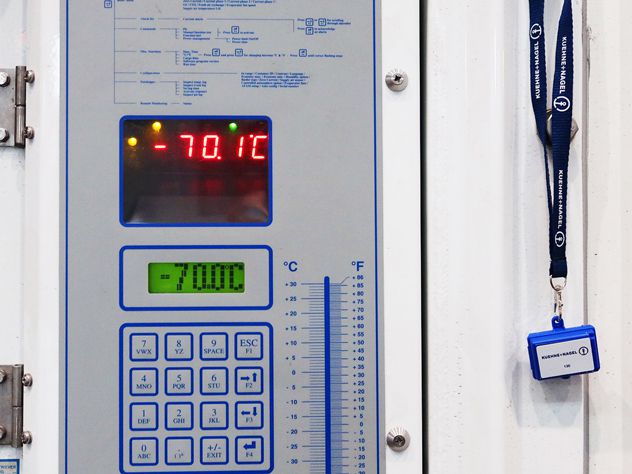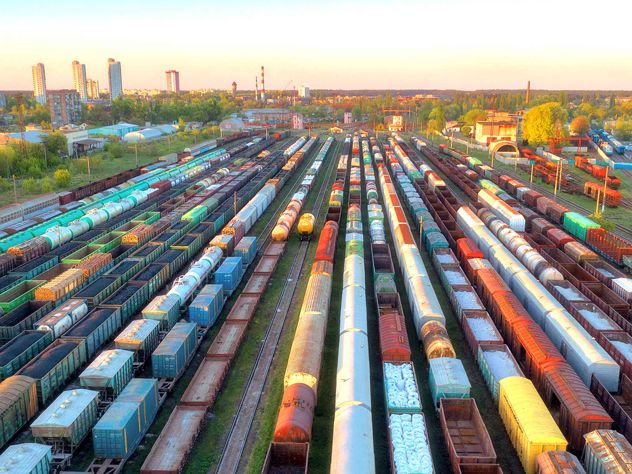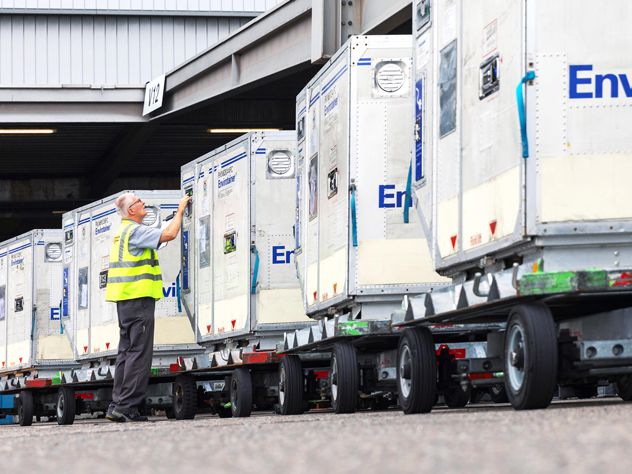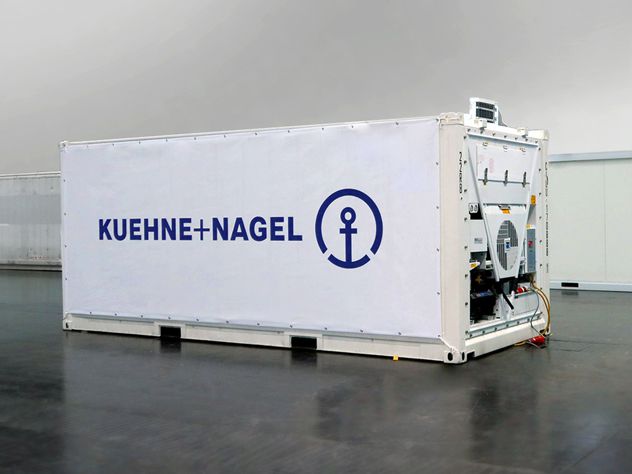Back Updates on Coronavirus
Services
Coronavirus Disease 2019 (COVID-19) Update
Update May 12, 2022: changes compared to last update in
- Sea Logistics: Asia Pacific
- Air Logistics: North America, South and Central America, Asia Pacific – Greater China in focus
- Road Logistics: no updates
General information

 Our employees and preventive health measures
Our employees and preventive health measures
The health and safety of our customers and employees remain our top priority. All Kuehne+Nagel offices have implemented actions according to recommendations from the World Health Organisation.
As regions differ in levels of spread and consequences of COVID-19, we adapt our business continuity measures accordingly. The Kuehne+Nagel commitment to operating under COVID-19 circumstances include responsibility on management side to have sites enabling social distance, staggered work schedules, safe commuting, frequent disinfection, cleaning procedures and more.
Our staff are successfully working from home where deemed necessary by local circumstances.
In regards to risk of virus on packages and pallets we receive and deliver, we deem the risk low, following WHO statement of "The likelihood of an infected person contaminating commercial goods is low and the risk of catching the virus that causes COVID-19 from a package that has been moved, travelled, and exposed to different conditions and temperature is also low."

 Business Continuity Program
Business Continuity Program
As a global logistics company, we are facing supply chain disruptions on a regular basis. We adapt continuously our global standards of business continuity management and test our Business Continuity Plans addressing different crisis scenarios.
They are designed to protect the safety and well-being of our employees and to ensure an uninterrupted service for our customers. In respect of the magnitude of the COVID-19 effect, we are executing new and continuous risk assessments, business impact analysis and implementing new measures into our business continuity framework based on alert levels.
All countries have established national response teams in order to either prepare for, or execute activation of these plans.
Where deemed appropriate by our national management teams and where required by governmental decrees, we activate preventive measures and processes, which include temperature control of employees and visitors (within the parameters set by locally applicable laws such as data protection laws), self-declarations, segregated/flexi work arrangements, options to work from home, the sanitisation of our offices and sites, and the provision of essential hygiene products at workplaces. Standard processes have also been defined in case of staff being infected or exposed to people who are infected.
We are sharing hygienic guidelines with our suppliers to ensure greater awareness within the supply chain. Drivers arriving for collection or delivery undergo a briefing on hygienic best practices, and where permissible, are instructed to fill out self-declarations.
We have implemented global travel restrictions and external and internal meetings are either conducted as video conferences, or only in the presence of a small number of participants observing social distancing recommendations as issued by public health authorities.
Impact on shipments and regions

 In general
In general
General situation
In general, the situation has become more stable but we still see some fluctuations. Equipment availability, available space, and blanked vessel sailings remain to have an impact on the overall situation.
Our local experts are at your full disposal to assist and support you with your specific requirements.

 North America
North America
General situation
Our sea logistics operations are fully functional. There are currently no restrictions in place that are impacting the domestic supply chains.
Space and equipment
-/-
Port congestion / delays
Port congestion and inland transport challenges result from the current strong American market demand and the overall tense situation on the sea freight market.
Further information on the current situation in the ports can be found at www.seaexplorer.com.

 South and Central America
South and Central America
General situation
There are currently no major restrictions on sea logistics operations due to Covid-19. The offices are still handling business, but with reduced staff or in home office mode.
In Brazil, operations are running with only minor limitations.
In Argentina and Uruguay report normal operations.
Bolivia and Peru suspended most Covid-19 restrictions. Still, delivery from ports is impacted as bordering countries have maintained closure of their land borders.
In Chile, all ports are in operation, but there is some congestion.
Guatemala, El Salvador, Honduras, Nicaragua, Costa Rica, and Panama report normal operations.
Space and equipment
We see medium-high impacts on equipment availability – especially reefer containers.
Port congestion / delays
The ports are operational, but delays may occur in the terminals due to reduced staff, reduced attention hours and local quarantine measures.
Further information on the current situation in the ports can be found at www.seaexplorer.com.

 Asia Pacific
Asia Pacific
General situation
As part of the ongoing lockdown in Shanghai, there are disinfection and quarantine measures implemented by local authorities to prevent the spread of Covid-19. Despite stricter precautionary and control measures being taken, we remain fully operational to give the least impact on our customers’ business.
Space and equipment
Equipment situation has normalised.
Port congestion / delays
Shanghai terminals remain business as usual including vessel operations, yard handling and gate-in and out. However, we expect waiting times to increase due to the increased stress on labour capacity.
Reefer imports to Shanghai have been temporarily suspended. Trucking services in and out of Shanghai remains affected by local restrictions and various checkpoints. The overall trucking operation efficiency is expected to decrease and arrival timeliness is adversely impacted due to highway congestion in particular.
Further information on the current situation in the ports can be found at www.seaexplorer.com.

 Europe
Europe
General situation
There are currently no major restrictions on operations due to the Coronavirus. However, the continuing high demand across the globe as well as ongoing equipment imbalances and restructuring measures of carriers lead to congestions in all major European ports and thus in substantially increased lead times.
Space and equipment
Equipment, especially in the hinterland depots, remains short across Europe. Space is tight and bookings must be placed 2-6 weeks in advance.
Port congestion / delays
Heavy delays of incoming vessels, as well as changes in sailing schedules on short notice, intensify container shortages.
Further information on the current situation in the ports can be found at www.seaexplorer.com.

 Middle East and Africa
Middle East and Africa
General situation
The Covid-19 situation in Middle East and Africa is stable.
Space and equipment
Economic activities continue undisturbed with no negative significance towards the overall performance. Equipment & space issues continue to create some bottlenecks. This is the "new normal".
Port congestion / delays
All parties involved (including ports) continue to operate under "new normal" conditions.
Further information on the current situation in the ports can be found at www.seaexplorer.com.

 In general
In general
General situation
Please see regional sections for updates.

 North America
North America
General situation
Carriers push forward their plans for added passenger capacity but continued restrictions in some regions, such as Asia Pacific, still create uncertainty. Many of the passenger flights are focused on travel destinations and do not necessarily add capacity where it is needed most. Even where passenger flights align with traditional cargo flows the available capacity is still not meeting overall demand.
Capacity
Kuehne+Nagel North America continues to secure space as needed based on customers unique supply chain needs. Capacity to and from North Asia is extremely challenged with the drastic reduction in flights due to government-imposed Covid-19 policies. Capacity on other trade lanes slowly recovers but remains at or below pre-pandemic levels while demand is generally much higher. Our specialists are able to find solutions for our clients and continue to do so with stringent planning and forecasting.
Airport congestion / delays
The market continues to face a shortage of labor. This is especially evident with the ground handling agents who are responsible for the buildup and breakdown of cargo moving in and out of North America. Export cargo generally moves with proper planning and coordination with our key airline partners. Import cargo can still take several days to be made available for recovery in key gateways like JFK and LAX.

 South and Central America
South and Central America
General situation
Covid-19 situation in the region is stable. There are currently no restrictions in plane and our air logistics operations are fully functional.
Capacity
Even though most of the carriers are operational, there is still significant lack of capacity overall in the region due to constraints on the sea freight side.
Airport congestion / delays
Brazil airports are congestioned due to customs strike, causing delays in customs clearance and retrieval of the cargo.
Overall in the region the airports are running in full capacity.

 Asia Pacific – Greater China in focus
Asia Pacific – Greater China in focus
General situation
The Covid-19 situation continues to vary across Greater China with some cities imposing lockdowns, while others putting restrictions and controls including quarantine requirements for cross-city traffic. Due to the rising cases in Shanghai and Kushan areas continue with large-scale lockdowns, which impact supply chain operations. On a positive side, the overall situation is gradually improving and more and more manufactures are resuming their operations.
Capacity
Most carrier operations from Pudong airport are suspended, with 60% of flights cancelled in April. Such situation is expected to continue till the lockdown is lifted. In addition, capacity challenges across the region continue due to Russian airspace restrictions leading to longer flying time, resulting in lower payloads.
Airport congestion / delays
Due to the new Covid-19 outbreak inbound capacity is tight in all China mainland airports due to suspended customer operations or trucking interruption in lockdown cities. Pudong airport operations continue to be disrupted. Transfer of cargo from Kuehne+Nagel warehouse to Pudong airport terminal is carried out with significant delays. Our teams have put alternate solutions in place to support the operations in/around the airport and also cross-border movement via Hong Kong gateway. Imports into CN/JP/KR are being supported via the Hong Kong gateway.

 Europe
Europe
General situation
As the virus continues to surge, our air freight operations in Europe are running stable. The demand for air freight on all trade lanes remains high.
Capacity
Capacity remains constraint on all trade lanes. The challenging situation in sea logistics continues to put additional pressure on the tight capacity situation as companies across all industries are shifting from sea freight to air freight to fulfill the needs of their customers.
Airport congestion / delays
All major airports in EUR struggle to handle the high volumes. Additionally, Covid-19 is effecting the available workforce which impacts the overall handling situation negatively.

 Middle East and Africa
Middle East and Africa
General situation
The operational situation in Middle East and Africa remains stable without any interruptions.
Capacity
As countries in MEA are re-opening for travel, carriers are re-instancing and increasing frequencies. QR and EK are re-converting passenger freighters back into passenger to meet the demand. With restrictions being lifted, capacity and frequency are approaching pre-Covid levels.
Aiport congestion / delays
Stable situation across the region.

 In general
In general
General situation
We take this opportunity to thank our drivers, who are tirelessly collecting and delivering shipments under challenging conditions. We also extend our thanks to our customers and recipients of shipments who allow our drivers access to their restrooms. We truly appreciate those who go out of their way to help our drivers do a great job. By all of us working together and showing respect to each other, we jointly contribute to keeping our supply chains afloat.

 Europe
Europe
General situation
Like European overland markets, the Kuehne+Nagel network is facing less restrictions compared to the spring period last year. The development on an overall European scale however is still rather volatile and impacted by still existing Covid19 limitations in certain areas. This can lead to some partial reroutings and small delays in selected lanes. The current expectations for the next weeks force us to keep the following pre-conditions in place until further notice.
For any country in Europe, we still strongly ask shippers to check the availability and readiness of their customers to receive shipments during business hours, before handing shipments over to us. Shipments which cannot be delivered due to absent consignees will be returned to shippers at their cost. In case shippers are not able to receive these returned shipments, storage cost will apply.
In case of pick-up orders customers also need to ensure readiness of their pick-up addresses. If this is not given, cost of the pick-up attempts will be charged.
Further customers need to ensure that consignee’s will confirm receipt of cargo.

 Asia Pacific
Asia Pacific
General situation
Trucking services in China are back to normal. Cross-border trucking to and from Hong Kong (SAR, China) and the China/ Vietnam border (Pingxiang border) is operating as per normal. Additionally, operation at the Vietnam and Laos/Cambodia border as well as domestic transportation within Vietnam are also back to normal.
For Thailand, domestic and cross-border movement for commercial and essential goods between Thailand and Myanmar/ Laos/ Cambodia is allowed. All drivers need to undergo health checks.
For cross-border trucking to Central Asian countries and Europe, there is heavy congestion at China/Kazakhstan border (Horgos and Alashankou borders) due to the preventative control measures for COVID-19.
Similarly, trucking to Europe via the China/Russia route (Manzhouli border) is also experiencing the same issue due to the increased control measures implemented.
The Malaysian government has announced nationwide Movement Control Order (MCO) starting May 12, 2021, till June 7, 2021 Movement of goods in and out of the country must adhere to the MCO standard operating procedure. We do not see any impact on domestic and cross border transportation.
Many Indian states have imposed strict lockdowns while other states have announced restrictions on public movement. This has no impact on domestic transportation.
The situation and border control measures in most of these countries are evolving rapidly as the COVID-19 situation continues to change. We are closely monitoring the situation and will provide further updates on this page.

 North America
North America
General situation
US, Canada and Mexico border restrictions only impact "non-essential" travel and do not apply to the transportation of goods and services. Stay-at-home orders around the country are being lifted in some states and extended in others, however these measures are not directed at commercial truck traffic. Check with individual partners on their operation status prior to shipping because nearly all LTL carriers will be returning freight immediately (<1 day) after a refusal due to a closed consignee. Cargo cannot be held at the destination due to large volumes of undeliverable freight resulting in additional charges.
US domestic truckload capacity is tightening, but federal and state governments are committed to keeping the supply chain moving. The majority of LTL and Small package carriers will suspend physical signatures. In adherence to the “Social Distancing” policy, drivers will not be obtaining signatures from consignees. Drivers will record the exact time, note any exceptions and obtain the name of the person who is accepting the freight. As spot market truckload rates rise to highly affected areas, less drivers are willing to take loads into these areas forcing the ad hoc rates to climb. Urgent orders of retail goods drive rates up for van and reefer equipment. Retailers, including e-commerce outlets, rely increasingly on spot market providers to re-stock shelves immediately, while truckers report long wait times at pickup and delivery points.
DISCLAIMER - All information is provided in good faith for guidance and reference purposes only. It is of a general informational nature, and Kuehne+Nagel takes no legal responsibility for the accuracy of the information provided via this document. Kuehne+Nagel makes no representation as to the accuracy or completeness of any of the information contained herein and accepts no liability for any loss arising from the use of the information provided.










